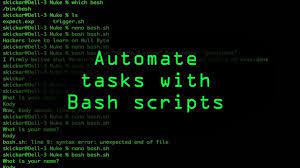Bash Scripting: Unlocking the Power of Automation
 Emmanuel Eziogor
Emmanuel Eziogor
Bash (Bourne Again SHell), a command processor that typically runs in a text window, is a powerful tool for automating repetitive tasks and streamlining complex processes on Unix-based systems. Bash scripting enables users to create custom scripts, combining a series of commands and logical constructs into a cohesive program.
Why Bash Scripting?
1. Automation: Bash scripts automate routine tasks, reducing manual intervention and minimizing the chance of errors. From file manipulation to system administration, automation is at the heart of Bash scripting.
2. Customization: Users can tailor Bash scripts to their specific needs. Whether it's setting up a development environment or configuring system settings, Bash scripting allows for fine-grained customization.
3. Efficiency: By scripting sequences of commands, users can execute tasks more efficiently. This is particularly beneficial for repetitive tasks, where a single well-crafted script can replace numerous manual commands.
**Basic Syntax:
- Shebang: Every Bash script begins with a shebang line (`#!/bin/bash`), indicating the path to the Bash interpreter.
- Variables: Variables store data for later use. They are created by assigning a value to a name: variable_name=value.
- Conditionals: if, else, and elif statements allow for conditional execution of code based on certain conditions.
- Loops: Bash supports for and while loops, enabling the repetition of commands or code blocks.
- Functions: Functions allow the organization of code into reusable blocks, enhancing script modularity.
Example Script:
```bash
#!/bin/bash
# This is a simple Bash script
echo "Hello, World!"
# Variables
name="John"
echo "My name is $name"
# Conditional
if [ "$name" == "John" ]; then
echo "I'm John!"
else
echo "I'm not John."
fi
# Loop
for i in {1..5}; do
echo "Count: $i"
done
```
Tips for Bash Scripting:
1. Comments: Use comments to explain the purpose of the code. This makes scripts more understandable for others (or your future self).
2. Error Handling: Implement error handling to make scripts robust. Check for command success/failure and react accordingly.
3. Testing: Test scripts in a controlled environment before deploying them to production systems.
4. Documentation: Maintain documentation for complex scripts, detailing the purpose, usage, and any dependencies.
5. Security: Be mindful of security best practices, especially when dealing with user inputs or system commands.
Bash scripting is a skill that empowers users to harness the full potential of the command line, making tasks more efficient and systems more manageable. Whether you're a system administrator, developer, or power user, Bash scripting is a valuable tool in your toolkit. Start exploring its capabilities and witness the transformative power of automation.
Subscribe to my newsletter
Read articles from Emmanuel Eziogor directly inside your inbox. Subscribe to the newsletter, and don't miss out.
Written by
